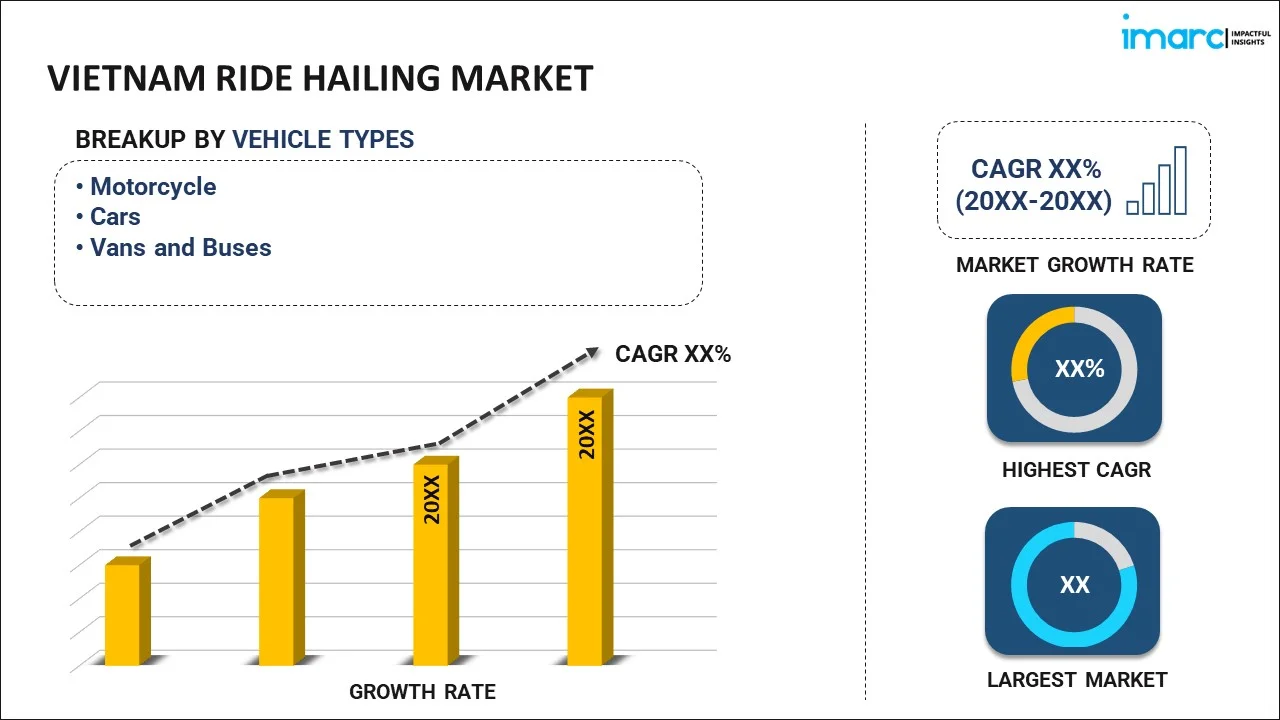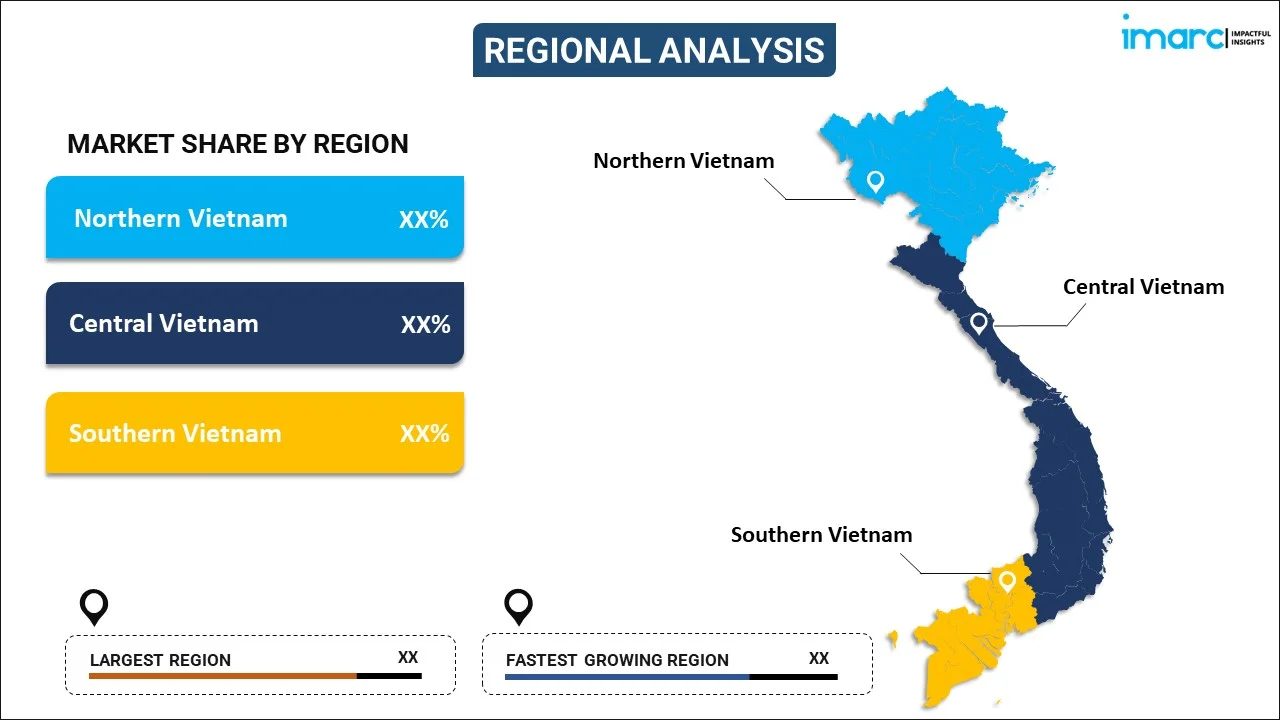
Vietnam Ride Hailing Market Report by Vehicle Type (Motorcycle, Cars, Vans and Buses), and Region 2025-2033
Market Overview:
Vietnam ride hailing market size reached USD 800 Million in 2024. Looking forward, IMARC Group expects the market to reach USD 4,300 Million by 2033, exhibiting a growth rate (CAGR) of 17.6% during 2025-2033. The market is growing steadily, pushed by urbanization, delivery app growth, and rising urban populations. Strong demand for on-demand delivery and taxi services has led providers to expand into food, grocery, and package delivery. The boom in online shopping, mobile apps, and ridesharing platforms adds flexible, affordable travel choices. Supportive government measures for digital transportation to ease congestion and boost mobility. Motorcycles dominate for their low cost in cities, with cars, vans, and buses covering longer or shared routes.
|
Report Attribute
|
Key Statistics
|
|---|---|
|
Base Year
|
2024
|
|
Forecast Years
|
2025-2033
|
|
Historical Years
|
2019-2024
|
|
Market Size in 2024
|
USD 800 Million |
|
Market Forecast in 2033
|
USD 4,300 Million |
| Market Growth Rate 2025-2033 | 17.6% |
Delivery ride hailing, also known as ride sharing, is a contemporary transportation service that leverages digital platforms to connect passengers with drivers using their personal vehicles. This innovative mode of transportation has gained significant popularity due to its convenience, affordability, and accessibility compared to traditional taxi services. Ride hailing companies offer mobile applications that enable passengers to request rides, track their drivers' location, and make cashless payments, enhancing the overall commuting experience. Besides this, they provide a source of income for drivers who use their own vehicles to offer rides. These services have transformed urban mobility, influencing traffic patterns, reducing the need for personal car ownership, and promoting shared transportation options as an efficient alternative to traditional taxis and public transportation.
Vietnam Ride Hailing Market Trends:
Growing Demand for Efficient Ride-Hailing
The country's burgeoning urban population and increasing traffic congestion have created a heightened demand for efficient transportation solutions, with ride hailing services offering a swift and convenient means of getting around crowded urban areas, primarily driving the market growth. In line with this, the proliferation of smartphones and internet connectivity has enabled widespread access to ride hailing platforms, further fueling their adoption. Furthermore, the flexibility it offers to drivers, allowing them to work on their schedules, has attracted a large pool of individuals seeking supplementary income opportunities, which, in turn, is creating a favorable outlook for market expansion. Besides this, the ongoing development of Vietnam's ride hailing infrastructure has facilitated cashless transactions, enhancing the convenience and security of ride hailing services, thereby impelling the market growth. Concurrently, increasing partnerships with local businesses, such as restaurants and hotels, diversifying the services offered by ride hailing companies, and creating synergies that benefit both passengers and drivers, are bolstering the market growth.
In confluence with this, extensive investments in safety and security measures, including driver background checks and global positioning system (GPS) tracking, boosting passenger confidence in these services are aiding in market expansion. Additionally, as environmental consciousness and cost-effectiveness become more prominent, people are increasingly opting for shared rides over owning private vehicles, thus propelling the market forward.
Emergence of Multifunctional Ride-Hailing Platforms
In Vietnam, ride-hailing services are more than ever providing passenger transport as they become integrated with delivery services. With increasing demand for quick deliveries, ride hailing apps in Vietnam allow drivers to alternate between passenger rides and parcel drop-offs. This approach improves efficiency and income potential. Efforts are also being directed towards sustainability, where companies strive to encourage the use of shared rides and fuel-efficient vehicles. These developments are part of a larger shift toward more sustainable city mobility, which aims to enhance traffic flow, reduce emissions, and alleviate environmental strain while meeting evolving consumer needs. The change is building a more responsive and sustainable transportation environment.
Collaboration between Public Transport and Ride-Hailing
Cooperation between ride-hailing firms and domestic public transport networks is promoting more integrated urban mobility solutions in Vietnam. As these services grow, delivery services and passenger transportation are becoming increasingly combined under one digital platform. This streamlines user convenience and fuels growth in the industry. Concurrently, Vietnam delivery platforms are also relying more on electric vehicles to help reduce costs and minimize environmental footprint. The increasing price of fuel, concerns about urban air quality, and government incentives are driving the transformation. Local electric vehicle producers are partnering with these platforms to introduce cleaner, lower-emission fleets in major cities such as Hanoi and Ho Chi Minh City.
Vietnam Ride Hailing Market Segmentation:
IMARC Group provides an analysis of the key trends in each segment of the market, along with forecasts at the country level for 2025-2033. Our report has categorized the market based on vehicle type.
Vehicle Type Insights:

- Motorcycle
- Cars
- Vans and Buses
The report has provided a detailed breakup and analysis of the market based on the vehicle type. This includes motorcycle, cars, and vans and buses.
Regional Insights:

- Northern Vietnam
- Central Vietnam
- Southern Vietnam
The report has also provided a comprehensive analysis of all the major regional markets, which include Northern Vietnam, Central Vietnam, and Southern Vietnam.
Competitive Landscape:
The market research report has also provided a comprehensive analysis of the competitive landscape in the market. Competitive analysis such as market structure, key player positioning, top winning strategies, competitive dashboard, and company evaluation quadrant has been covered in the report. Also, detailed profiles of all major companies have been provided.
Vietnam Ride Hailing Market Recent News:
- May 2025: Lalamove launched motorcycle and car ride-hailing services in Ho Chi Minh City, expanding its platform beyond delivery. The move introduced affordable transport options with transparent pricing and boosted income opportunities for drivers, strengthening competition and diversifying Vietnam’s market.
- January 2025: Bolt began recruiting drivers and staff in Ho Chi Minh City, marking its official entry into Vietnam’s ride-hailing sector. Competing with Grab, Xanh SM, and Be, Bolt’s arrival increased market competition and offered new income opportunities for drivers in the growing urban mobility space.
- December 2024: Vingroup launched its electric taxi service, Xanh SM, in Jakarta through its ride-hailing unit GSM. Featuring a fleet of VinFast electric cars, the expansion marked Vingroup’s entry into Indonesia, promoting sustainable urban transport and strengthening its regional presence in the ride-hailing sector.
Vietnam Ride Hailing Market Report Coverage:
| Report Features | Details |
|---|---|
| Base Year of the Analysis | 2024 |
| Historical Period | 2019-2024 |
| Forecast Period | 2025-2033 |
| Units | Million USD |
| Scope of the Report | Exploration of Historical Trends and Market Outlook, Industry Catalysts and Challenges, Segment-Wise Historical and Future Market Assessment:
|
| Vehicle Types Covered | Motorcycle, Cars, Vans and Buses |
| Regions Covered | Northern Vietnam, Central Vietnam, Southern Vietnam |
| Customization Scope | 10% Free Customization |
| Post-Sale Analyst Support | 10-12 Weeks |
| Delivery Format | PDF and Excel through Email (We can also provide the editable version of the report in PPT/Word format on special request) |
Key Benefits for Stakeholders:
- IMARC’s industry report offers a comprehensive quantitative analysis of various market segments, historical and current market trends, market forecasts, and dynamics of the Vietnam ride hailing market from 2019-2033.
- The research report provides the latest information on the market drivers, challenges, and opportunities in the Vietnam ride hailing market.
- Porter's five forces analysis assist stakeholders in assessing the impact of new entrants, competitive rivalry, supplier power, buyer power, and the threat of substitution. It helps stakeholders to analyze the level of competition within the Vietnam ride hailing industry and its attractiveness.
- Competitive landscape allows stakeholders to understand their competitive environment and provides an insight into the current positions of key players in the market.
Key Questions Answered in This Report
The Vietnam ride hailing market is expected to grow at a CAGR of 17.6% during 2025-2033.
Vietnam’s ride-hailing sector is expanding due to rising urban populations, increased smartphone access, and a preference for app-based convenience. Growth in delivery services, along with government support for tech-enabled transport and strong digital payment adoption, continues to push the market forward.
The pandemic initially caused a sharp drop in ride-hailing activity due to lockdowns and safety concerns. In response, companies shifted focus toward deliveries and hygiene measures. This adjustment reshaped user expectations, encouraged platform innovation, and helped ride-hailing services regain momentum in a cautious, health-conscious environment.
Based on the vehicle type, the Vietnam ride hailing market has been segmented into motorcycle, cars, and vans and buses.
On a regional level, the Vietnam ride hailing market has been segmented into Northern Vietnam, Central Vietnam, Southern Vietnam.
Need more help?
- Speak to our experienced analysts for insights on the current market scenarios.
- Include additional segments and countries to customize the report as per your requirement.
- Gain an unparalleled competitive advantage in your domain by understanding how to utilize the report and positively impacting your operations and revenue.
- For further assistance, please connect with our analysts.
 Request Customization
Request Customization
 Speak to an Analyst
Speak to an Analyst
 Request Brochure
Request Brochure
 Inquire Before Buying
Inquire Before Buying




.webp)




.webp)












